- Home
- News Releases
- Back Issues
- October FY2023
- Five Key Points to Confirm for Safe Use of Oil Heaters in the Beginning of Winter Season to Prevent Fire Accidents
Five Key Points to Confirm for Safe Use of Oil Heaters in the Beginning of Winter Season to Prevent Fire Accidents
October 26, 2023
Joint Press Release with the Consumer Affairs Agency and the National Institute of Technology and Evaluation (NITE)
Oil heaters and oil fan heaters (hereinafter referred to as "oil heaters, etc.") are good tools to keep rooms warm and comfortable. Nevertheless, many accidents are usually reported to have occurred from around every November in the beginning of the winter season. The Ministry of Economy, Trade and Industry (METI) hereby presents users five key points to confirm before starting to use oil heaters, etc. at this time of year when users start using oil heaters, etc. so as to help them master their correct use and prevent fire accidents.
According to the product accident information*1 reported to the National Institute of Technology and Evaluation (NITE), there were 269 accidents involving oil heaters, etc. during the five-year period from FY2018 to FY2022.*2 Of the 233 accidents for which investigations have been completed, the accidents caused by incorrect use or carelessness were 115, accounting for the largest number by cause. In addition, the number of accidents involving victims aged 70 or older was 131, showing a tendency to increase as the age of the victims increases, and 31 of the 47 fatal accidents involve victims belonging to this age bracket, accounting for the majority.
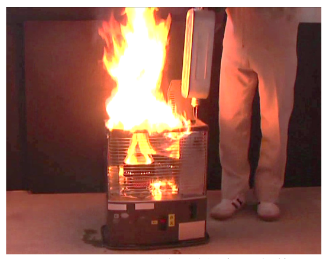
*Notes:
- These accidents include 203 serious product accidents reported under the Consumer Products Safety Act as well as 66 non-serious product accidents and minor but potentially dangerous incidents (with no damage), information on which is collected under the NITE’s Accident Information Collection System.
- This data targets the accidents happened from April 1, 2018, to March 31, 2023.
Five key points to confirm before starting the use of oil heaters, etc.
Key point 1: Remove any accumulated dust.
Key point 2: Confirm that the anti-seismic device to automatically extinguish fire is working properly. If using an oil heater, confirm that the combustion cylinder is properly installed.
Key point 3: Use fresh kerosene as fuel and do not use kerosene remaining from the last winter season, and thoroughly take measures to prevent the incorrect fueling of an oil heater with gasoline.
Key point 4: Confirm that the fueling-inlet cap of the cartridge tank is tightly closed and if there are no leaks.
Key point 5: Confirm that there is sufficient distance between the oil heater and nearby walls or combustible materials.Approaches to preventing elderly people from being involved in accidents caused by oil heaters, etc.
Even if you have been using an oil heater for many years, confirm the correct use once again. METI recommends a family member or a person nearby to help an elderly person to confirm the condition of the oil heater and how to use it.
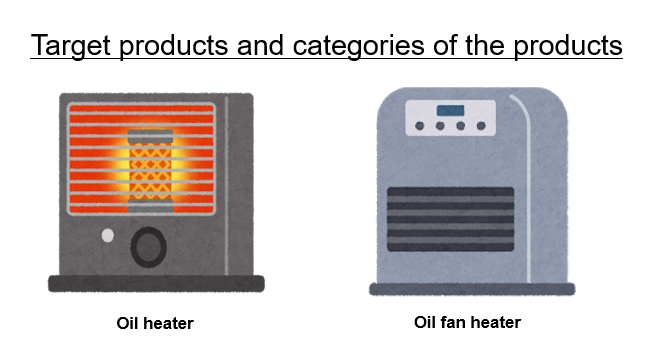
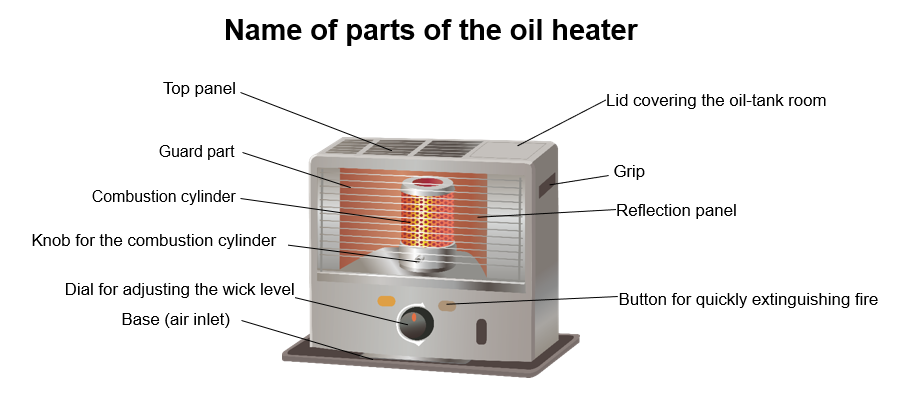
1. Situation surrounding accidents
According to the product accident information reported to NITE, there were 269 accidents involving oil heaters and other products during the period from FY2018 to FY2022. The situation surrounding these accidents is shown below.
1-1. Number of accidents by fiscal year
Figure 1 shows the number of product accidents by fiscal year. Looking at the number of accidents caused by oil heaters, etc. over the past five years, the overall number of accidents remained flat, while that of accidents leading to injuries tended to increase.
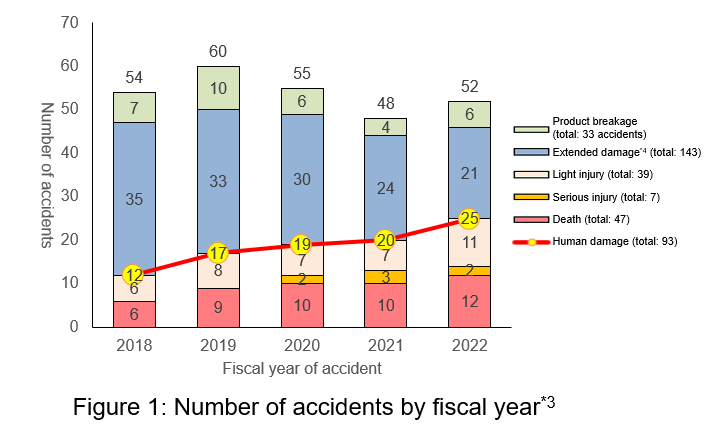
*Notes:
- Even in cases of any physical damage (product breakage or extended damage), those involving injury are classified in the human damage category. In cases of multiple accidents involving injury (death, serious injury, or light injury) occurring simultaneously, the number of accidents is counted in the most serious injury category, and no duplicate counts are made.
- The term “extended damage” refers to damage not only to the product itself (product breakage) but also to surrounding products, buildings, etc.
1-2. Number of accidents by month
According to the product accident information reported to NITE from FY2018 to FY2022, there were 269 accidents involving oil heaters, etc. For a breakdown, the number of accidents by month is shown in Figure 2 below. Accidents increased from around November and it was found that the increase was in accordance with the increase in occasions to use oil heaters, etc.
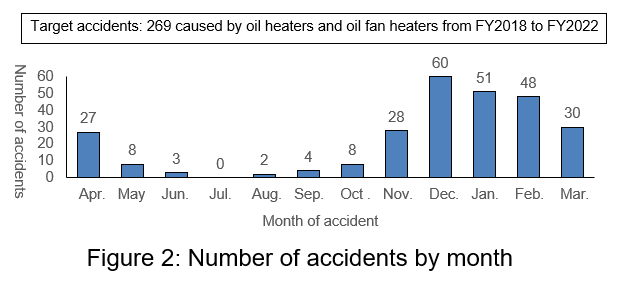
1-3. Number of accidents by cause
According to the product accident information reported to NITE from FY2018 to FY2022, there were 269 accidents involving oil heaters, etc. For a breakdown of 233 for which investigations have been completed out of the 269 accidents, the number of accidents by cause is shown in Figure 3 below. Of this, 115 accidents (49%) were caused by incorrect use or carelessness.
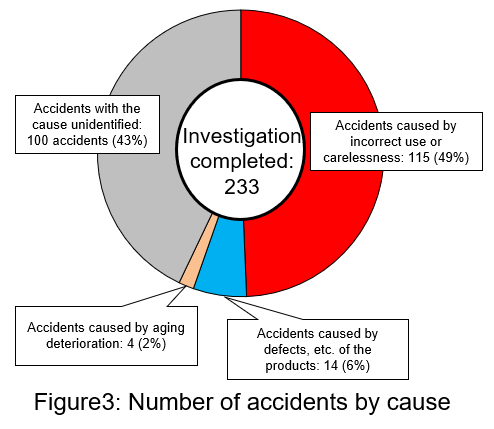
1-4. Number of damages by event
According to the product accident information reported to NITE from FY2018 to FY2022, there were 269 accidents involving oil heaters, etc. For a breakdown of 115 that were caused by incorrect use or carelessness out of the 269 accidents, the number of damages by event is shown in Table 1 below.
Many accidents were caused by “kerosene leaks from the fueling-inlet cap,” “incorrect fueling of the oil heater with gasoline” and “a combustible material having contact with the oil heater.” This data indicates that product accidents caused by these events may lead to serious fire accidents, to which users should take special attention.
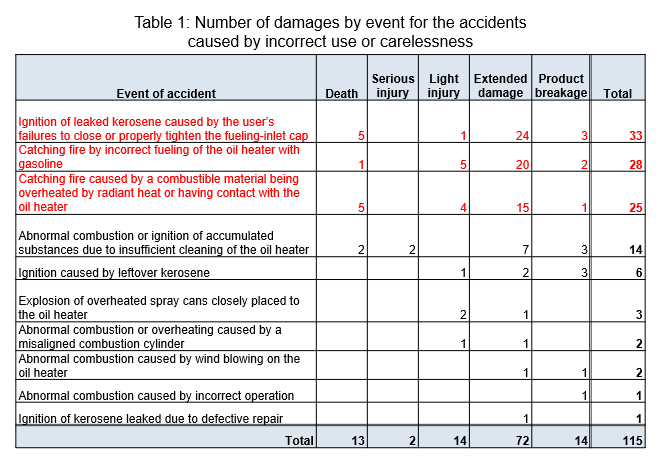
1-5. Number of damages by age bracket of the victims
According to the product accident information reported to NITE from FY2018 to FY2022, there were 269 accidents involving oil heaters, etc. For a breakdown of 206, about which the age brackets of the victims have been uncovered, out of the 269 accidents, the number of accidents by age bracket of the victims is shown in Figure 4 below. As many as 131 accidents in total involved victims aged 70 or older, and this accounts for the majority of all victims. As for fatal accidents, there were 31 cases involving elderly people in total, showing an increase in the number of accidents involving elderly people. The causes of these accidents involving elderly people are considered to be a decline in judgment and physical functions with aging, and carelessness due to familiarity with the use of oil heaters for many years.
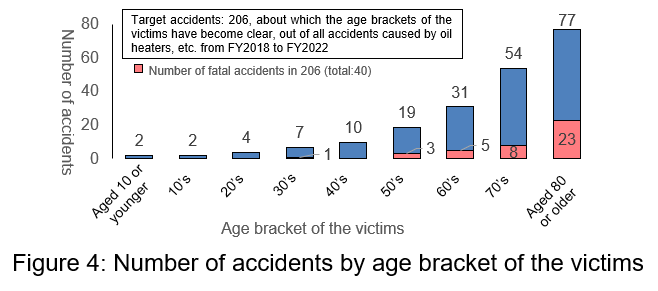
2. Examples of accidents
2-1. Abnormal combustion or ignition of accumulated dust due to insufficient care of an oil heater
Date of the accident
November 2022 (Kanagawa Prefecture; male in his 50s; seriously injured)
Details of the accident
An oil heater in use caught fire, causing the surroundings to ignite and one person to be seriously injured.
Cause of the accident
It was found that some carbonized materials were accumulated under the air inlet of the oil heater and that scorching and discoloration were seen on the surface of the base. Based on this, it was considered that the dust and other substances accumulated on the base blocked air flow of the heater, causing a blowback phenomenon,*5 causing the dust and other substances to ignite and expanding the fire.
Key words for the SAFE-Lite search engine*6
Oil heater, dust
*Notes:
- The term “blowback phenomenon” refers to the phenomenon in which fire flows backward out of the air inlet due to insufficient absorption of air in the equipment and other factors.
- The SAFE-Lite
 website is a NITE online search tool exclusively for finding product accidents.
website is a NITE online search tool exclusively for finding product accidents.
2-2. Abnormal combustion caused by an incorrectly aligned combustion cylinder
Date of the accident
February 2019 (Tokushima Prefecture; male of unknown age; extended damage)
Details of the accident
An oil heater in use caught fire to break out, causing the surroundings to be damaged.
Cause of the accident
Abnormal combustion occurred due to an incorrectly aligned combustion cylinder, and this was considered to cause a large fire, leading to an accident.
Key words for the SAFE-Lite search engine
Oil heater, combustion cylinder, incorrect alignment
2-3. Incorrect fueling of an oil heater with gasoline
Date of the accident
February 2022 (Chiba Prefecture; female in her 70s; extended damage)Details of the accident
An oil heater in use caught fire, causing two buildings to totally burn down.
Cause of the accident
As gasoline components were found in the cartridge tank and inside part of the oil heater, it was considered that the fueling of the oil heater with kerosene mixed with gasoline caused the accident. Although it is unknown why the user incorrectly fueled the oil heater with the kerosene-gasoline mixture, the container for kerosene was found to be stored in the same building as the gasoline carrying can, and an inflated gasoline carrying can with the fueling-inlet cap removed was found at the accident site.
Key words for the SAFE-Lite search engine
Oil heater, gasoline
2-4. Ignition of spilled kerosene caused by the user’s failures to close and properly tighten the fueling-inlet cap
Date of the accident
April 2022 (Kyoto Prefecture; female in her 70s; extended damage)
Details of the accident
An oil heater in use caught fire, causing one building to totally burn down and extending to two other buildings, causing them to ignite.
Cause of the accident
It was considered that the user failed to fully tighten the fueling-inlet cap of the oil heater after filling the cartridge tank with kerosene, and the cap came off and kerosene spilled out when she placed the tank back into the heater. Then the spilled kerosene splashed from the heater top to the combustion cylinder, causing the heater to ignite and extending the fire to the surroundings.
Key words for the SAFE-Lite search engine
Oil heater, tank, spilling
2-5. Close contact with nearby combustible materials
Date of the accident
December 2021 (Miyagi Prefecture; male in his 80s; light injury)
Details of the accident
An oil fan heater in use caught fire, causing a building to totally burn down and one person to be lightly injured.
Cause of the accident
The hot air outlet of the oil fan heater was placed closely to the futon blanket covering a kotatsu (table with a heater attached), and this was believed to extremely heat the blanket, causing the blanket to ignite. The victim had weak eyesight and could not see well the distance between the heater and the blanket.
Keywords for the SAFE-Lite search engine
Oil fan heater, close contact, contact
3. Key points to confirm before starting the use of oil heaters
Key point 1 to confirm in using oil heaters, etc.
Remove accumulated dust.
Accumulated dust or other substances on an oil heater may cause poor combustion conditions or cause the flame to blow backwards from underneath the heater (called the “blowback phenomenon”), leading the dust to ignite.
Also, the air inlet of the oil fan heater clogged with dust may cause abnormal combustion. It was reported that such situation caused a product accident.
Clean your oil heater before using it in the beginning of the winter season and clean it again even during the season on a regular basis. In particular, ensure not to allow dust to accumulate on the base of the oil heater or near the parts surrounding the combustion part.
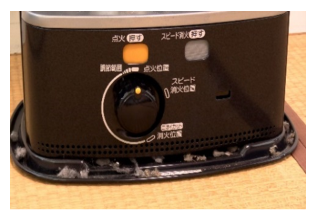
Key point 2 to confirm in using oil heaters, etc.
Confirm that the anti-seismic device to automatically extinguish fire is working properly.
Confirm that the anti-seismic device to automatically extinguish fire is working properly. If the wick of the oil heater does not move smoothly, the anti-seismic device to automatically extinguish fire does not work properly because the wick will not be lowered enough, and this may cause poor fire extinguishing performance.
When you confirm that the device is working properly, see if the wick of your oil heater fully goes down from the top level to the bottom level or if your oil fan heater in operation stops once you rock the body of the heater back and forth. For details on how to confirm, see the safety instructions of the product.
Confirm that the combustion cylinder is properly installed (in case of oil heaters)
Confirm that the combustion cylinder properly sets by moving the dial of the cylinder a few times when you set the cylinder or turn on the heater. If the cylinder does not set properly, abnormal combustion may happen, fire may come out of the heater and cause the heater to ignite, or a high level of carbon monoxide may emit from the heater.
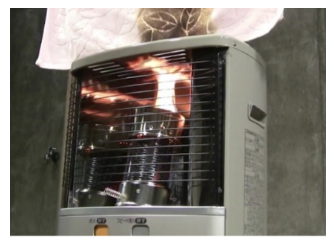
Key point 3 to confirm in using oil heaters, etc.
Use fresh kerosene as fuel and do not use kerosene remaining from the last winter season. Thoroughly take measures for preventing the incorrect fueling of an oil heater with gasoline.
Fuel an oil heater, etc. with fresh kerosene. Using degraded kerosene remaining from the last winter season may facilitate abnormal combustion or carbon monoxide emissions. Remove such kerosene remaining from the last winter season from the tank or the body of the heater. For how to dispose degraded kerosene, contact the retailer from which you purchased the kerosene.
In addition, incorrect fueling of an oil heater with gasoline or mixed fuel, even a small amount, may catch fire and cause a highly serious accident. Some accidents caused by this incorrect fueling were reported, such as the following: a user kept kerosene and gasoline using two similar containers, unintentionally mixed them, and incorrectly fueled an oil heater with the mix; and another user kept gasoline and kerosene in the same place and incorrectly fueled an oil heater, mistaking gasoline for kerosene. Thoroughly take measures for preventing the incorrect fueling of an oil heater with gasoline, such as keeping kerosene in a special container,*7 such as a polyethylene tank, while keeping gasoline in a metal gasoline carrying can that satisfies the Fire Service Act, and keeping kerosene and gasoline in separate sites or labeling kerosene and gasoline respectively to differentiate them.
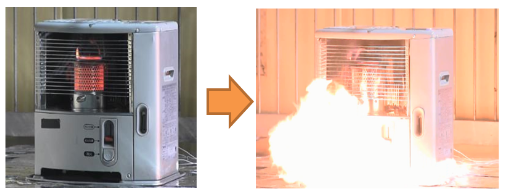

right: Gasoline carrying can
*Note:
- The term “special container for kerosene” refers to a container to which a certified safety sticker is attached, including safety stickers recommended by the Japan Polyethylene Blow Molding Products Association (JBA), test and verification certificates issued by the Hazardous Materials Safety Techniques Association (KHK), and stickers with a JIS mark (JIS Z 1710: Blow molded polyethylene containers for kerosene).
You can follow the following approach to distinguish between kerosene and gasoline.
Note: Wash your hands with a lot of water and soap immediately after you conduct this approach.
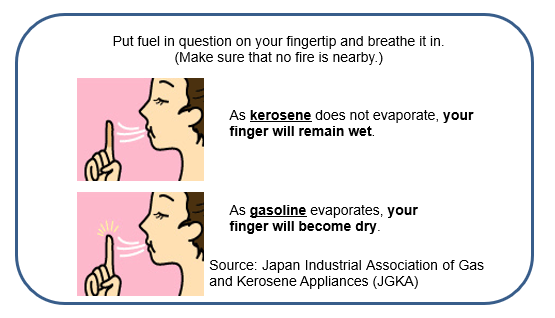
Key point 4 to confirm in using oil heaters, etc.
Confirm that the fueling-inlet cap of the tank is tightly closed after fueling the tank and if there is no spilling before setting the tank back to the oil heater.
It was reported that a user failed to tightly close the fueling-inlet cap of the cartridge tank and the spilled kerosene caused the oil heater to ignite. Make sure to tightly close the fueling-inlet cap following fueling the cartridge tank before setting the tank back to the heater, and make sure to turn off the heater first before fueling the tank.
If you find kerosene spilled over the heater, stop using it and contact the retailer or manufacturer as the spilled kerosene may enter the inside of the heater.
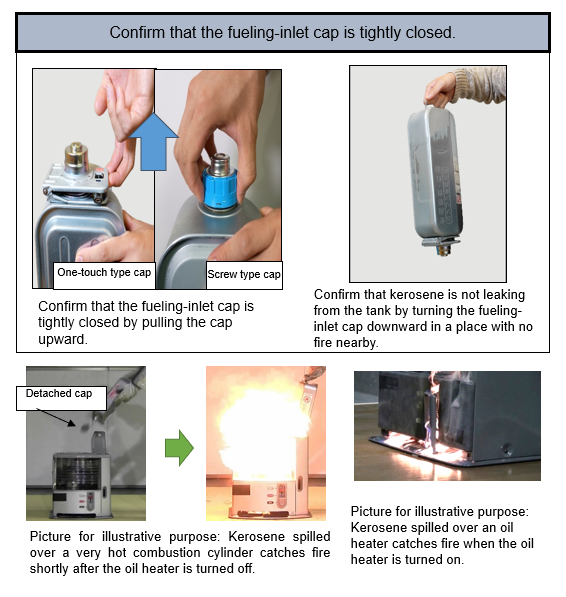
Confirm that the fueling-inlet cap is tightly closed by making use of a safety function.
An oil heater with a PSC mark sticker attached has a function that helps a user to confirm that the fueling-inlet cap is tightly closed by making clicking sounds when the cap is being closed, showing a visual sign, or providing a sense of touch.
Note: Oil heaters and other oil burning appliances were designated as "specified products" under the Consumer Products Safety Act in 2009, and businesses are not allowed to sell any products without a PSC mark attached from 2011.
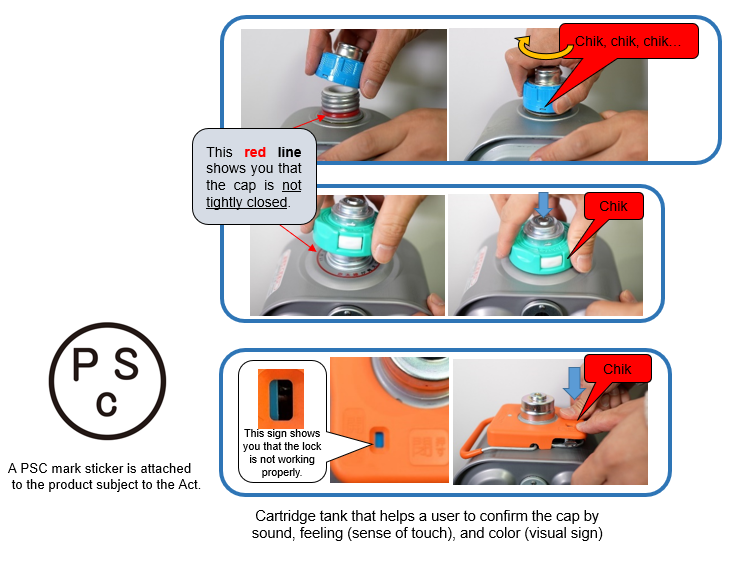
Key point 5 to confirm in using oil heaters, etc.
Confirm that there is sufficient distance between the oil heater and nearby objects, the ceiling, or walls.
Make sure to keep the predetermined distance from nearby walls, furniture, clothing, etc. when using the oil heater, etc. Also, keep attention to light materials that are not fixed and easily catch fire, such as curtains and bedding. If you place any combustible materials near or in contact with an oil heater, such materials may catch fire because of radiant heat*8 from or their contact with the very hot parts of the heater.
*Note:
- The term “radiant heat” refers to the heat that is transferred to distant locations by infrared radiation emitted by a very hot object.
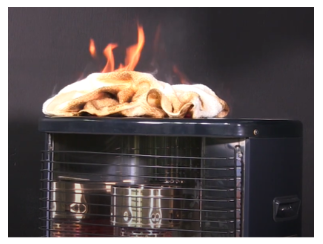
Example of the product instructions for maintaining distance from an oil heater
Confirm the safety instructions of your oil heater to find the explanation on maintaining distance from nearby goods, ceiling, walls, and other objects.
Note: The predetermined distance differs among products.
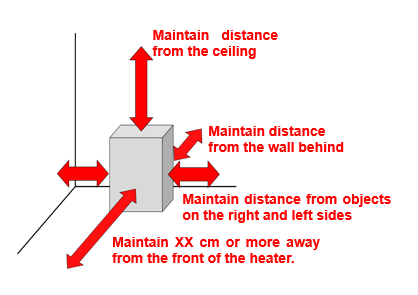
4. Accidents caused by elderly people
Approaches to preventing elderly people from being involved in accidents caused by oil heaters, etc.
Even if you are accustomed to using an oil heater for many years, confirm the correct use once again. METI recommends a family member or a person nearby to help an elderly person to confirm the condition of the oil heater and how to use it.
Many product accidents, in particular, those caused by elderly people, have been reported. Many of such accidents involving elderly people were caused by kerosene that spilled from the fueling-inlet cap of the cartridge tank that was not tightly closed and incorrect fueling of an oil heater with gasoline. The background to these accidents is considered to be associated with a decline in physical and cognitive functions with aging, including declined grip strength insufficient to tightly close the fueling-inlet cap, having declined capability to make sure that the cap is tightly closed, and having difficulty in sensing the smell of gasoline. Even if you have been able to use the oil heater correctly, never let your guard down and make sure of correct use once again.
Moreover, not all users may be able to pay ceaseless attention to not cause an accident. METI recommends a family member or a person nearby to confirm that the elderly person can handle an oil heater correctly and tell him/her how to use it, while referring to the key points to confirm above.
If you have been using an old oil heater for many years, pay strong attention when using it. If you find any defects in the heater, including damage, deformation, or abnormal operation, or if you find that your heater is subject to a recall,*9 stop using the product immediately.

*Note:
- To access information on recalls, visit the websites for the recall information run by: respective companies, the Consumer Affairs Agency
 , METI, and the NITE AR-SHOT
, METI, and the NITE AR-SHOT , a NITE smartphone application.
, a NITE smartphone application.
See video clip for the key points to confirm oil heaters, etc.
METI and JGKA jointly developed a video clip to raise public awareness of oil heaters to help users to confirm the key points by following the instruction flow when starting the use of an oil heater.
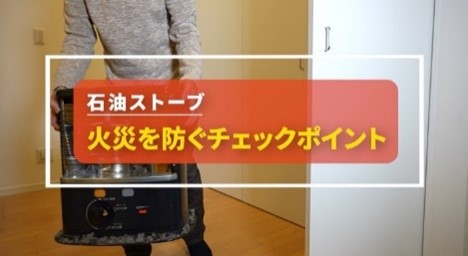
Division in Charge
- Product Accident Information and Analysis Office, Product Safety Division, Industrial and Product Safety Policy Group
- Consumer Safety Division, Consumer Affairs Agency
- Product Safety Technology Center, National Institute of Technology and Evaluation